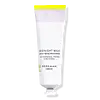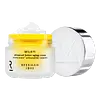What's inside
What's inside
 Key Ingredients
Key Ingredients

 Benefits
Benefits

 Concerns
Concerns

 Ingredients Side-by-side
Ingredients Side-by-side

Water
Skin ConditioningGlycerin
HumectantGlyceryl Stearate
EmollientCetyl Alcohol
EmollientNeopentyl Glycol Diheptanoate
EmollientGlyceryl Caprylate
EmollientSqualane
EmollientPalmitoyl Tripeptide-38
Skin ConditioningCaprae Lac
Skin ConditioningMilk Protein
Skin ConditioningLactose
HumectantBifida Ferment Lysate
Skin ConditioningBakuchiol
AntimicrobialMelatonin
AntioxidantHyaluronic Acid
HumectantIsododecane
EmollientMelia Azadirachta Flower Extract
Skin ConditioningStearic Acid
CleansingGlyceryl Stearate Citrate
EmollientHydroxyacetophenone
AntioxidantPanthenol
Skin ConditioningCoccinia Indica Fruit Extract
Skin ConditioningCarbomer
Emulsion StabilisingAllantoin
Skin ConditioningXanthan Gum
EmulsifyingCaprylhydroxamic Acid
Glyceryl Laurate
EmollientBetaine
HumectantSodium Hydroxide
BufferingCentella Asiatica Extract
CleansingHydroxypropyl Cyclodextrin
MaskingSpinacia Oleracea Leaf Extract
Skin ConditioningSodium Carbonate
BufferingPropanediol
SolventTephrosia Purpurea Seed Extract
Skin ConditioningAcetyl Hexapeptide-8
HumectantGardenia Florida Fruit Extract
Skin ConditioningMaltodextrin
AbsorbentWater, Glycerin, Glyceryl Stearate, Cetyl Alcohol, Neopentyl Glycol Diheptanoate, Glyceryl Caprylate, Squalane, Palmitoyl Tripeptide-38, Caprae Lac, Milk Protein, Lactose, Bifida Ferment Lysate, Bakuchiol, Melatonin, Hyaluronic Acid, Isododecane, Melia Azadirachta Flower Extract, Stearic Acid, Glyceryl Stearate Citrate, Hydroxyacetophenone, Panthenol, Coccinia Indica Fruit Extract, Carbomer, Allantoin, Xanthan Gum, Caprylhydroxamic Acid, Glyceryl Laurate, Betaine, Sodium Hydroxide, Centella Asiatica Extract, Hydroxypropyl Cyclodextrin, Spinacia Oleracea Leaf Extract, Sodium Carbonate, Propanediol, Tephrosia Purpurea Seed Extract, Acetyl Hexapeptide-8, Gardenia Florida Fruit Extract, Maltodextrin
Water
Skin ConditioningC15-19 Alkane
SolventStearic Acid
CleansingCaprylic/Capric Triglyceride
MaskingGlycerin
HumectantCoco-Caprylate/Caprate
EmollientButyrospermum Parkii Butter
Skin ConditioningGlyceryl Stearate Se
EmulsifyingCetyl Alcohol
EmollientSqualane
EmollientPropanediol
SolventButylene Glycol
Humectant1,2-Hexanediol
Skin ConditioningCetearyl Olivate
Mangifera Indica Seed Butter
Skin ConditioningSorbitan Olivate
EmulsifyingNiacinamide
SmoothingCaprylhydroxamic Acid
Carbomer
Emulsion StabilisingTrichilia Emetica Seed Butter
EmollientEthylene/Propylene/Styrene Copolymer
Caprae Lac
Skin ConditioningAllantoin
Skin ConditioningXanthan Gum
EmulsifyingLactose
HumectantBifida Ferment Lysate
Skin ConditioningMilk Protein
Skin ConditioningCitrus Aurantium Bergamia Fruit Oil
MaskingSodium Hydroxide
BufferingHydrolyzed Collagen
EmollientButylene/Ethylene/Styrene Copolymer
Polyglutamic Acid
Skin ConditioningCaprylyl Glycol
EmollientCeramide NP
Skin Conditioning2,3-Butanediol
HumectantTocopherol
AntioxidantHydrogenated Lecithin
EmulsifyingPentaerythrityl Tetra-Di-T-Butyl Hydroxyhydrocinnamate
AntioxidantGlyceryl Stearate
EmollientSodium Carbonate
BufferingCholesterol
EmollientCeramide As
Skin ConditioningCeramide AP
Skin ConditioningCeramide Ns
Skin ConditioningNicotiana Benthamiana Hexapeptide-40 Sh-Polypeptide-76
Skin ConditioningCeramide EOP
Skin ConditioningWater, C15-19 Alkane, Stearic Acid, Caprylic/Capric Triglyceride, Glycerin, Coco-Caprylate/Caprate, Butyrospermum Parkii Butter, Glyceryl Stearate Se, Cetyl Alcohol, Squalane, Propanediol, Butylene Glycol, 1,2-Hexanediol, Cetearyl Olivate, Mangifera Indica Seed Butter, Sorbitan Olivate, Niacinamide, Caprylhydroxamic Acid, Carbomer, Trichilia Emetica Seed Butter, Ethylene/Propylene/Styrene Copolymer, Caprae Lac, Allantoin, Xanthan Gum, Lactose, Bifida Ferment Lysate, Milk Protein, Citrus Aurantium Bergamia Fruit Oil, Sodium Hydroxide, Hydrolyzed Collagen, Butylene/Ethylene/Styrene Copolymer, Polyglutamic Acid, Caprylyl Glycol, Ceramide NP, 2,3-Butanediol, Tocopherol, Hydrogenated Lecithin, Pentaerythrityl Tetra-Di-T-Butyl Hydroxyhydrocinnamate, Glyceryl Stearate, Sodium Carbonate, Cholesterol, Ceramide As, Ceramide AP, Ceramide Ns, Nicotiana Benthamiana Hexapeptide-40 Sh-Polypeptide-76, Ceramide EOP
 Reviews
Reviews

Ingredients Explained
These ingredients are found in both products.
Ingredients higher up in an ingredient list are typically present in a larger amount.
Allantoin is a soothing ingredient known for its protective and moisturizingg properties. Because of this, it is often added to products with strong active ingredients.
Studies show higher concentrations of this ingredient can promote wound healing.
Though it can be derived from the comfrey plant, allantoin is produced synthetically for cosmetic products to ensure purity.
Learn more about AllantoinBifida Ferment Lysate is derived from the fermentation of Bifida bacteria (often with dairy). It is a probiotic and helps to strengthen our skin's microbiome.
Having a healthy microbiome helps protect our skin against infection. It also helps our skin stay hydrated and healthy.
Studies also show this ingredient to be a promising soothing ingredient for sensitive skin.
Learn more about Bifida Ferment LysateWe don't have a description for Caprae Lac yet.
Caprylhydroxamic Acid is a chelating agent.
Chelating agents help prevent metal ions from binding to other ingredients. This helps prevent unwanted reactions and effects from using the product.
Caprylhydroxamic Acid is often used with natural antimicrobial products as an alternative to preservatives.
Learn more about Caprylhydroxamic AcidCarbomer is a polymer of acrylic acid. Its main role is to create a gel consistency.
A high amount of carbomer can cause pilling or balling up of products. Don't worry, most products contain 1% or less of carbomer.
Cetyl Alcohol is a fatty alcohol. Fatty Alcohols are most often used as an emollient or to thicken a product.
Its main roles are:
Though it has "alcohol" in the name, it is not related to denatured alcohol or ethyl alcohol.
The FDA allows products labeled "alcohol-free" to have fatty alcohols.
Learn more about Cetyl AlcoholGlycerin is already naturally found in your skin. It helps moisturize and protect your skin.
A study from 2016 found glycerin to be more effective as a humectant than AHAs and hyaluronic acid.
As a humectant, it helps the skin stay hydrated by pulling moisture to your skin. The low molecular weight of glycerin allows it to pull moisture into the deeper layers of your skin.
Hydrated skin improves your skin barrier; Your skin barrier helps protect against irritants and bacteria.
Glycerin has also been found to have antimicrobial and antiviral properties. Due to these properties, glycerin is often used in wound and burn treatments.
In cosmetics, glycerin is usually derived from plants such as soybean or palm. However, it can also be sourced from animals, such as tallow or animal fat.
This ingredient is organic, colorless, odorless, and non-toxic.
Glycerin is the name for this ingredient in American English. British English uses Glycerol/Glycerine.
Learn more about GlycerinGlyceryl Stearate is a mix of glycerin and stearic acid.
It is used to stabilize the mixing of water and oil ingredients. By preventing these ingredients from separating, it can help elongate shelf life. It can also help thicken the product's texture.
As an emollient, it helps soften skin and supports barrier-replenishing ingredients.
In cosmetics, Glyceryl Stearate is often made from vegetable oils or synthetically produced.
This ingredient may not be fungal-acne safe
Fun fact: The human body also creates Glyceryl Stearate naturally.
Learn more about Glyceryl StearateWe don't have a description for Lactose yet.
We don't have a description for Milk Protein yet.
Propanediol is an all-star ingredient. It softens, hydrates, and smooths the skin.
It’s often used to:
Propanediol is not likely to cause sensitivity and considered safe to use. It is derived from corn or petroleum with a clear color and no scent.
Learn more about PropanediolWe don't have a description for Sodium Carbonate yet.
Sodium Hydroxide is also known as lye or caustic soda. It is used to adjust the pH of products; many ingredients require a specific pH to be effective.
In small amounts, sodium hydroxide is considered safe to use. However, large amounts may cause chemical burns due to its high alkaline.
Your skin has a natural pH and acid mantle. This acid mantle helps prevent harmful bacteria from breaking through. The acid mantle also helps keep your skin hydrated.
"Alkaline" refers to a high pH level. A low pH level would be considered acidic.
Learn more about Sodium HydroxideSqualane is an emollient that helps the skin hold onto moisture. It's an oily liquid that occurs naturally in certain types of fish and plant oils.
Because squalane boosts hydration in the skin, it also comes with plenty of benefits: it is an antioxidant and can help fight free radicals and skin damage. Squalane is also found to have a detoxifying effect when applied.
Squalane comes from squalene, which occurs naturally within the sebum of our skin. It is one of the oils our skin produces to keep itself hydrated. Squalane is the hydrogenated version of squalene and has a longer shelf life.
Research shows that squalane is non-irritating (even at 100% concentration).
In general, it's a fantastic ingredient. It does a great job at hydrating the skin, and it's suitable for those with sensitive skin.
The source of squalane may impact malassezia / fungal acne. This is because olive oil derived squalane can contain impurities such as fatty acids and plant waxes. Sugarcane derived squalane is recommended for anyone with malassezia concerns.
Is squalane vegan?
This depends on the source. Squalane can be derived from both plants and animals. Most squalane used in skincare comes from plants.
Please note: the source of squalane is only known if disclosed by the brand. We recommend reaching out to the brand if you have any questions about their squalane.
Read more about squalene with an "e".
Is squalane an oil?
Squalane is often called an oil, but it’s technically not; it’s a hydrocarbon, meaning it’s only made of carbon and hydrogen, unlike true oils which are triglycerides made of fatty acids and glycerol.
The term “oil-free” isn’t regulated, so companies can define it however they want. Some exclude all oils, while others just avoid mineral oil or comedogenic oils.
While some people avoid oils thinking they cause breakouts, the right kind of oil (or oil-like ingredient like squalane) can actually help balance and hydrate your skin. It’s worth testing out simple oils or squalane to see what works best for your skin.
Learn more about SqualaneStearic Acid is a fatty acid. It is an emollient, emulsifier, and texture enhancer.
As an emollient, stearic acid helps soften skin. It aids the skin's protective barrier by preventing water loss. It also provides a gentle cleansing effect without stripping away natural oils.
Stearic acid may also be used to enhance the texture of products. It can add volume and stabilize ingredients such as water and oil. This can help water and oil ingredients from separating.
Sources of stearic acid include animal or vegetable fats/oils such as coconut or shea. It can be naturally found in butter, cocoa butter, shea butter, vegetable fats, and animal tallow.
This ingredient may not be Malassezia folliculitis, or fungal-acne safe.
Learn more about Stearic AcidWater. It's the most common cosmetic ingredient of all. You'll usually see it at the top of ingredient lists, meaning that it makes up the largest part of the product.
So why is it so popular? Water most often acts as a solvent - this means that it helps dissolve other ingredients into the formulation.
You'll also recognize water as that liquid we all need to stay alive. If you see this, drink a glass of water. Stay hydrated!
Learn more about WaterXanthan gum is used as a stabilizer and thickener within cosmetic products. It helps give products a sticky, thick feeling - preventing them from being too runny.
On the technical side of things, xanthan gum is a polysaccharide - a combination consisting of multiple sugar molecules bonded together.
Xanthan gum is a pretty common and great ingredient. It is a natural, non-toxic, non-irritating ingredient that is also commonly used in food products.
Learn more about Xanthan Gum